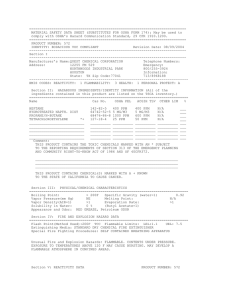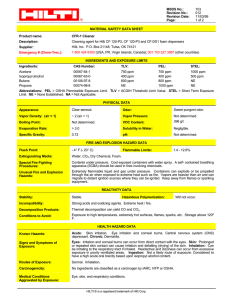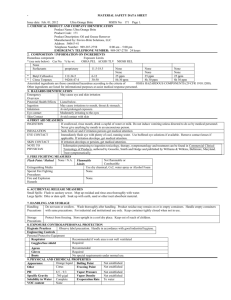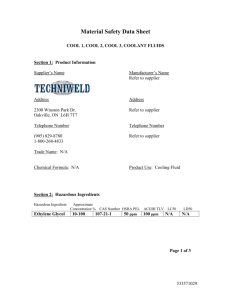Natural Gasoline - EnLink Midstream
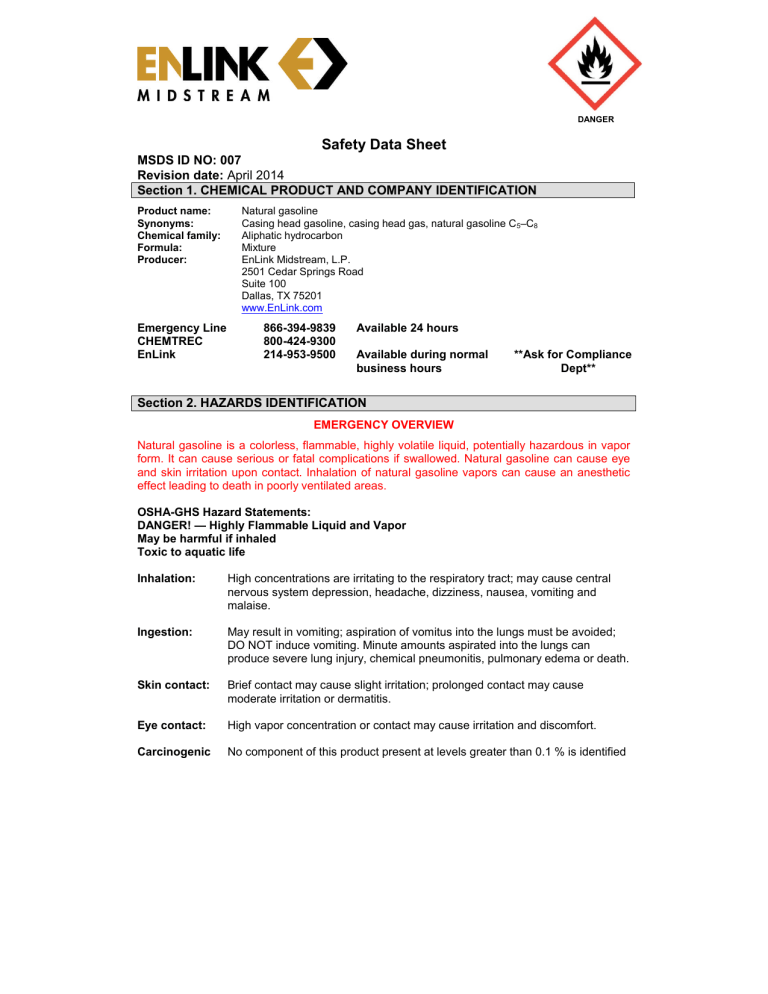
DANGER
Safety Data Sheet
MSDS ID NO: 007
Revision date: April 2014
Section 1. CHEMICAL PRODUCT AND COMPANY IDENTIFICATION
Product name:
Synonyms:
Chemical family:
Formula:
Producer:
Emergency Line
CHEMTREC
EnLink
Natural gasoline
Casing head gasoline, casing head gas, natural gasoline C
5
–C
8
Aliphatic hydrocarbon
Mixture
EnLink Midstream, L.P.
2501 Cedar Springs Road
Suite 100
Dallas, TX 75201 www.EnLink.com
866-394-9839 Available 24 hours
800-424-9300
214-953-9500 Available during normal business hours
**Ask for Compliance
Dept**
Section 2. HAZARDS IDENTIFICATION
EMERGENCY OVERVIEW
Natural gasoline is a colorless, flammable, highly volatile liquid, potentially hazardous in vapor form. It can cause serious or fatal complications if swallowed. Natural gasoline can cause eye and skin irritation upon contact. Inhalation of natural gasoline vapors can cause an anesthetic effect leading to death in poorly ventilated areas.
OSHA-GHS Hazard Statements:
DANGER! — Highly Flammable Liquid and Vapor
May be harmful if inhaled
Toxic to aquatic life
Inhalation: High concentrations are irritating to the respiratory tract; may cause central nervous system depression, headache, dizziness, nausea, vomiting and malaise.
Ingestion: May result in vomiting; aspiration of vomitus into the lungs must be avoided;
DO NOT induce vomiting. Minute amounts aspirated into the lungs can produce severe lung injury, chemical pneumonitis, pulmonary edema or death.
Skin contact: Brief contact may cause slight irritation; prolonged contact may cause moderate irritation or dermatitis.
Eye contact: High vapor concentration or contact may cause irritation and discomfort.
Carcinogenic No component of this product present at levels greater than 0.1 % is identified
evaluation: as a known, suspected or potential carcinogen by the NTP, the IARC or
OSHA.
Section 3.
COMPOSITION / INFORMATION ON INGREDIENTS
Natural gasoline is a complex combination of hydrocarbons (predominantly C
5 through C
8
) separated as a liquid from natural gas and natural gas concentrates. Methane, ethane, propane and butanes have been extracted. It is a liquid at atmospheric temperatures and pressure.
Material information:
Isopentane
N-pentane
Isohexane
Name
N-hexane
Cyclohexane
Toulene
N-heptane
Dimethylpentanes
Dimethylcyclo-heptanes
Methyl heptanes
CAS No.
78-78-4
109-66-0
107-83-5
110-54-3
110-82-7
108-88-3
142-82-5
Mixture
Mixture
Mixture
Weight %
15-40
13-25
10-17
5-9
5-7
2-5
2-5
1-5
1-5
1-5
Note: The above weight percentages are represented in ranges as estimates. Due to variations in feedstock sources, components of natural gasoline may vary.
Section 4. FIRST AID MEASURES
Inhalation: Remove the affected person to fresh air; if the affected person is not breathing or breathing is irregular, provide artificial respiration, CPR and/or oxygen by trained personnel and seek emergency medical attention.
Skin contact: Remove contaminated clothing; wash affected area with soap and water; launder contaminated clothing before reuse; if irritation persists, seek medical attention.
Ingestion:
Eye contact:
DO NOT induce vomiting; if vomiting occurs spontaneously, keep head below hips to prevent aspiration of liquid into lungs; seek immediate medical attention. Vomiting may be induced only under the supervision of a physician.
Check for and remove contact lenses. Flush eyes with clear running water for
15 minutes while holding eyelids open; if irritation persists, seek medical attention.
Section 5. FIREFIGHTING MEASURES
Suitable extinguishing media:
Small fires — Class B fire-extinguishing media such as CO
2, dry chemical, foam (AFFF/ATC) or water spray can be used Larger fires — water spray, fog or foam (AFFF/ATC) can be used. Firefighting should be attempted only by those who are adequately trained and equipped with proper protective equipment.
Specific hazards: This product has been determined to be a flammable liquid per the OSHA
Hazard Communication Standard and should be handled accordingly.
Vapors may travel along the ground or be moved by ventilation and ignited by many sources such as pilot lights, sparks, electric motors, static
EnLink Midstream LP Natural Gasoline Page 2 of 7
Special protective equipment for firefighters:
NFPA rating:
Health:
Flammability:
Instability/reactivity:
Other: discharge or other ignition sources at locations distant from material handling. Flashback can occur along vapor trail. For additional fire-related information, see NFPA 30 or the North American Emergency Response
Guide 128.
Avoid using straight water streams. Water may be ineffective in extinguishing low flash point fires, but can be used to cool exposed surfaces. Avoid excessive water spray application. Water spray and foam (AFFF/ATC) must be applied carefully to avoid frothing and from as far a distance as possible. Keep runoff water out of sewers and water sources.
FIRE
2
3
1
N/A
L
T
H
H
E
A
2
3
1
R
E
A
C
T
I
V
I
T
Y
Hazardous
FP – 73 to 100 F
Unstable if Heated
N/A
SPECIAL
Section 6. ACCIDENTAL RELEASE MEASURES
Personal precautions: STEPS TO BE TAKEN IN THE EVENT MATERIAL IS RELEASED
OR SPILLED: Immediately contact emergency personnel. Use suitable personal protective equipment (Section 8). Evacuate and ventilate area; confine and absorb into absorbent material; place material into approved containers for disposal. For spills in excess of allowable quantities (RQ), notify the National Response Center at
(800) 424-8802. Refer to CERCLA 40 CFR and SARA Title III,
Section 313 40 CFR 372 for detailed instructions concerning reporting requirements.
Section 7. HANDLING AND STORAGE
Handling: Keep container closed when not in use; protect containers from abuse; protect from extreme temperatures. CAUTION – EXTREMELY FLAMMABLE – keep away from all sources of ignition. Empty containers may contain residue that may form explosive vapors. Do not weld or cut near empty container. Use nonsparking tools when opening and closing containers. Maintain well-ventilated work areas to minimize exposure when handling this material. Comply with all applicable EPA, OSHA, NFPA and consistent state and local requirements. Use appropriate grounding and bonding practices.
Avoid skin contact. Exercise good personal hygiene, including removal of soiled clothing and prompt washing with soap and water. Product should never be used as a solvent due to its flammable and potentially toxic properties. Siphoning by mouth can result in lung aspiration, which can be harmful or fatal.
Hydrocarbons are basically non-conductors of electricity and can become electrostatically charged during mixing, filtering and pumping at high flow rates or loading and transfer operations. If this charge reaches a sufficiently high level, sparks can form that may ignite the vapors of flammable liquids. Sudden release of hot organic chemical vapors or mists from process equipment operating under elevated temperature and pressure or sudden ingress of air into vacuum equipment may result in ignitions without the presence of obvious ignition
EnLink Midstream LP Natural Gasoline Page 3 of 7
sources. Nozzle spouts must be kept in contact with the containers or tank during the entire filling operation. A buildup of static electricity can occur upon re-entry into a vehicle during transfer, especially in cold or dry climate conditions. The charge is generated by the action of dissimilar fabrics (clothing or upholstery) rubbing across each other as a person enters/exits the vehicle. A flash fire can result from this discharge if sufficient flammable vapors are present. Therefore, do not get back in your vehicle while transfer is in progress.
Section 8. EXPOSURE CONTROLS / PERSONAL PROTECTION
Occupational Exposure Limits:
Name
Isopentane
N-pentane
Isohexane
N-hexane
Cyclohexane
Toluene
N-heptane
Dimethylpentanes
Dimethylcycloheptanes
Methyl heptanes
CAS No.
78-78-4
109-66-0
107-83-5
110-54-3
110-82-7
108-88-3
142-82-5
Mixture
Mixture
Mixture
Weight
%
OSHA — PEL
(ppm)
ACGIH
®
TLV
®
(ppm)
15-40 1,000 600
(pentane/isomers)
13-25 1,000; 600
A 600 ppm
10-17 Not established 500; 1,000 STEL
5-9
5-7
2-5
500
300
50
100
20 ppm
2-5
200;
300 ceiling;
100
A
500 400 ppm
1639 mg/m
3
1-5
1-5
1-5
Not established
Not established
Not established
Not established
Not established Not established
NIOSH REL
(ppm)
120; 610 STEL
1000 ppm
100; 510 STEL
50
300
200 ppm;
300 ceiling
500 ppm
2000 mg/m
3
Not established
Not established
Not established
All exposure limits listed are 8-hour time weighted average (TWA) — except where noted otherwise.
TWA — Time Weighted Average is an average value of exposure over the course of an 8-hour work shift.
PEL — Permissible Exposure Limit is the maximum amount or concentration of a chemical that a worker may be exposed to under OSHA regulations.
A
Federal OSHA 1989 PELs were vacated but are in use and enforced by many state OSHA plans.
Engineering measures: The use of local exhaust ventilation is recommended to control emissions near the source. Provide mechanical ventilation of confined spaces. Use explosion-proof ventilation equipment.
PERSONAL PROTECTIVE EQUIPMENT
Respiratory protection: None required while threshold limits are kept below maximum allowable concentrations; if TWA exceeds limits, NIOSH-approved respirator must be worn. Refer to 29 CFR 1910.134 for complete regulations.
Skin and body protection: Neoprene, butyl or nitrile rubber gloves with cuffs
Eye protection: Chemical splash goggles. Refer to 29 CFR 1910.133.
Hygiene measures: Minimize body contact with this, as well as all chemicals in general. Wash hands before eating, drinking, smoking, or using toilet facilities. Promptly remove contaminated clothing and launder before reuse.
EnLink Midstream LP Natural Gasoline Page 4 of 7
Section 9. PHYSICAL AND CHEMICAL PROPERTIES
Appearance:
Physical state (solid/liquid/gas):
Substance type (pure/mixture):
Color:
Odor:
Molecular weight: pH:
Boiling point/range (5-95%):
Melting point/range:
Decomposition temperature:
Specific gravity:
Density:
Vapor density:
Colorless liquid
Liquid
Mixture
Colorless
Gasoline odor
N/A
N/A
100°F
N/A
N/A
0.6-0.7
5.0-5.8 pounds/gallon
1.0-3.9
Vapor pressure:
Evaporation rate:
Flash point:
Auto-ignition temperature:
517-698 mm Hg @ 100°F
No data available
-20°F
437°F
Flammable limits in air — (lower): 1.2%
Flammable limits in air — (upper): 7.5%
Section 10. STABILITY AND REACTIVITY
Stability:
Polymerization:
This material is stable at 70°F, 760 mm pressure.
Will not occur.
Hazardous decomposition products: Combustion produces carbon monoxide, aldehydes, aromatic and other hydrocarbons.
Materials to avoid: Strong oxidizers such as nitrates, chlorates, peroxides
Conditions to avoid: Sources of heat or ignition
Section 11. TOXICOLOGICAL INFORMATION
Acute toxicity: May be harmful if inhaled (GHS category 5)
Components — Hazardous
Product information:
Name
Natural gasoline C
5
-C
8
CAS No.
68425-31-0
Inhalation: Dermal:
No data available No data available
Oral:
No data available
Summary of health effect information on the product: refer to Health Hazard Section 2
Section 12. ECOLOGICAL INFORMATION
Ecotoxicity effects: The product can cause fouling of shoreline and may be harmful to aquatic life in low concentrations. This product does not concentrate or accumulate in the food chain.
The aquatic toxicity of gasoline is as follows:
Freshwater toxicity:
LD
50 is 8 ppm at 96 hours in bluegill.
EnLink Midstream LP Natural Gasoline Page 5 of 7
TLm is 90 ppm at 24 hours in juvenile shad.
Saltwater toxicity:
LC
50
: 2 ppm at 96 hours in mullet
LD
50
: 1.5 ppm at 96 hours in grass shrimp
LC
50
: 2 ppm at 96 hours in menhaden
TLm: 91 ppm at 24 hours in juvenile shad
LC
50
— The concentration of the chemical in air that kills 50% of the test animals in a given time (usually four hours)
TLV — Threshold Limit Values are guidelines (not standards) that reflect the level of exposure that the typical worker can experience without an unreasonable risk of disease or injury.
TLm — Median Threshold Limit
Section 13. DISPOSAL CONSIDERATIONS
Cleanup considerations: This product as produced is not specifically listed as an EPA
RCRA hazardous waste according to federal regulations (40 CFR
261). However, when discarded or disposed of, it may meet the criteria of a “characteristic” hazardous waste. This product could also contain benzene at > 0.05 ppm and could exhibit characteristics of “toxicity” as determined by the toxicity characteristic leaching procedure (TCLP). This material could become hazardous waste or other substance(s). It is the responsibility of the user to determine if disposal material is hazardous according to federal, state and local regulations.
Section 14. TRANSPORT INFORMATION
Please refer to 40 CFR 172.101:
DOT:
Transport information: This product, when transported via U.S. commerce, would be regulated by DOT regulations.
Proper shipping name:
UN/identification no.:
Gasoline
UN 1203
Hazard class:
Packing group:
3
II
DOT reportable quantity (lbs): N/A
Section 15. REGULATORY INFORMATION
U.S. TSCA (Toxic Substance Control Act)
All components of this product are listed on the U.S. Toxic Substances Control Act
Chemical Inventory (TSCA Inventory) or are exempted from listing because a Low
Volume Exemption has been granted in accordance with 40 CFR 723.50.
SARA TITLE III Sections 311/312 Hazardous Categories (40 CFR 370.21)
ACUTE:
CHRONIC:
FIRE:
REACTIVITY:
HEALTH HAZARD
HEALTH HAZARD
FIRE HAZARD
NO
SUDDEN RELEASE: NO
EnLink Midstream LP Natural Gasoline Page 6 of 7
313 REPORTABLE INGREDIENTS
This product is a toxic chemical subject to annual reporting requirements of Section 313 of the Emergency Planning and Community Right-To-Know Act of 1986 and of 40 CFR
372.
CERCLA
The Comprehensive Environmental Response, Compensation and Liability Act
(CERCLA) has notification requirements for releases or spills to the environment of the reportable quantity (RQ for this mixture > 24,000 lbs) or greater amounts, according to
40 CFR 302.
This product contains benzene in concentrations less than 0.1%.
NOTE: User must consult with applicable state and local agencies for special specifics, determinations or compliance obligations regarding this product .
Section 16. OTHER INFORMATION
The information and recommendations contained herein are based upon tests, data, and information resources believed to be reliable. However, EnLink Midstream, L.P., and its related operations or divisions (EnLink) do not guarantee the accuracy or completeness, nor shall any of this information constitute a warranty, whether expressed or implied, as to the safety of goods, the merchantability of the goods or the fitness of the goods for a particular purpose. Adjustment to conform to actual conditions of usage may be required. EnLink assumes no responsibility for results obtained or for incidental or consequential damages, including lost profits, arising from the use of this data. No warranty against infringement of any patent, copyright or trademark is made or implied .
EnLink Midstream LP Natural Gasoline Page 7 of 7
